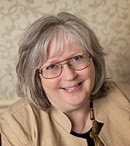by Sarah Sally Hamer @SarahSallyHamer
Creativity is NOT a straight line. Most of us have been taught to think in a linear fashion, where one thought follows another in an orderly and specific way. But that's not how it works. Our brains are made up of trillions of cells, which all connect in varying ways. The connections are based on association, where each one hooks to something similar.
For instance, if I ask you to describe a banana, you would probably describe it as a curved yellow fruit, tubular in shape, sweet in flavor, soft in texture, and the perfect ingredient for a banana pudding. You might remember your mom cutting one up in your cereal or watching a monkey open it from the "flower" instead of the stem end. All of these things come from your experiences of a banana, and from interconnected brain neurons. I've listed the description in very specific details but, in our brain, those neurons may live in very different places.
The term "yellow" for instance isn't only about bananas. Millions of things are yellow, from the sun, to a sunflower, to butter, to a crayon, to clouds during a sunset. And each of the neurons that are connected to "banana" are also connected to the other items I've mentioned because they all fall into the category of yellow. It works that way with everything in our mind—things are connected by association.
That's why creativity is, well, creative. We all have neurons with unique connections in our brains to our own experiences. Therefore, we are accessing different ideas than anyone else. Of course, there are cultural similarities—I'm the middle child but the oldest girl out of five children so I have specific ideas about how families work that belong to me. Your experience will probably be different than mine, simply because you may be an only child, the oldest, or the youngest. And some areas of the world don't have yellow bananas. Or someone may never have even seen a banana. But all of our brains work in the same way.
So the questions become: How do you create? How does your brain work? Where do your ideas come from? Are you utilizing all of possibilities?
Do you ever get asked where you get ideas for your books? I do, all the time. But I can't really explain where those ideas come from, although I often try. I do believe writers work in a "spiral of creativity," where the interconnection of neurons in our brains allow us to see things from a different perspective than the rest of the world. Each of us has a perspective, of course, but writers can apply those perspectives to non-existent people, our characters, and to non-existent situations, our plots. And, stories appear, almost as if by magic. Of course, it's not really magic, it's a lifetime of building stories in our heads. Ideas flow, even if we're not paying attention.
Where do you think your ideas come from? Are they based on specific experiences in your life? Do you recognize yourself—and others—in your characters? I do. My "core" protagonist, whether she's in a contemporary story, somewhere in space, or long ago in time, is always the same because she's "me" at least to some extent. I do create monsters sometimes in my books but they still harbor a tiny piece of me somewhere. Because I don't have the ability to write about something I don't know.
What do you think? I'd love to hear where your ideas come from—and how you turn those ideas into stories.
Learn more from Sally and six other amazing writers by attending the “Polishing Your Mirror: Self-Care for Writers” Symposium, March 23-24, 2024. Visit MindPotential.org for more info!
TWEETABLE
Sarah (Sally) Hamer, B.S., MLA, is a lover of books, a teacher of writers, and a believer in a good story. Most of all, she is eternally fascinated by people and how they 'tick'. She’s passionate about helping people tell their own stories, whether through fiction or through memoir. Writing in many genres—mystery, science fiction, fantasy, romance, medieval history, non-fiction—she has won awards at both local and national levels, including two Golden Heart finals.
A teacher of memoir, beginning and advanced creative fiction writing, and screenwriting at Louisiana State University in Shreveport for over twenty years, she also teaches online for Margie Lawson at WWW.MARGIELAWSON.COM. Sally is a free-lance editor and book coach at Touch Not the Cat Books, with many of her students and clients becoming successful, award-winning authors.
You can find her at INFO@MINDPOTENTIAL.ORG


This is a very interesting and informative article Sarah (Sally). I wonder what a person would think if he never saw a yellow banana. He lived somewhere in the deepest jungles of Africa, and I handed him a yellow banana and told him it was a banana.
ReplyDeleteI write personal essays and have been dabbling in Creative Nonfiction.
At times when I am writing, I look out into a thick, wooded area, called my backyard and I watch and listen to what is happening. There are some interesting stories that come from these observations. There is always life going on either underground or above, depending on the season.
Thank you for your article, I look forward to your next piece.
Thank you, Art. I also have an amazing backyard that brings me both inspiration and joy.
ReplyDeleteAnd, actually, that banana story is based on a perspective presentation I love to give -- we all have our own perspective, based on our experiences and yes -- some people have never seen a banana. Amazing to consider, right?